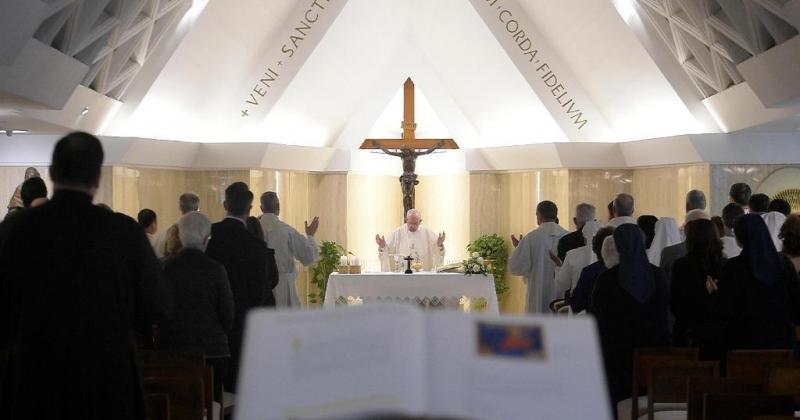Francis in Santa Marta: the couple in love are the image and likeness of God. “Marriage is a silent homily for everyone else, a daily homily”. Faith cannot be reduced to “you can or you cannot, yes or no” answers.
Two lovers resemble God. This is the greatest beauty of marriage. Francis exclaims in this morning’s Mass, 25 May 2018, at Casa Santa Marta, to which celebration, seven married couples celebrating their 25th and 50th wedding anniversaries were also present.
The Pontiff - Vatican News reports – took cue from today’s Gospel according to Mark, in which we read of the will of the Pharisees to test Jesus with a question that the Bishop of Rome defines as “case study”, i.e. those kind of questions about faith that can be summarized in a “you can or you cannot” and in which the faith “is reduced to a yes or no” answer. Francis points out: “Not the great “yes” or the great “no”. That is God. No, it’s about “you can or you cannot”. And the Christian life, the life according to God, according to these people, is always a matter of “you can” and “you cannot””.
The question asked to Christ concerns marriage: they want to know from him if a husband is allowed or not to repudiate his wife. The Pope emphasizes that the Son of the Lord goes beyond, goes up high, and “goes as far as Creation and speaks of marriage which is perhaps the most beautiful thing” created by God. Pope Bergoglio analyzes Jesus’ words: “ From the beginning of creation, God made them male and female. For this reason, a man shall leave his father and mother, and be joined to his wife, and the two shall become one flesh”: for the Pontiff, what the Lord says is “strong”, because he pronounces on “one flesh” which cannot be divided. Christ “lays aside the problem of separation, and goes to the beauty of the couple”.
Francis exhorts us not to dwell, “like these doctors do, on “Yes, you can”, or “No, you can’t” divide a marriage. This is ... At times there is misfortune, it does not work and it is better to separate to avoid a world war, but this is a misfortune. Let’s us look at the positive.
Jorge Mario Bergoglio tells of a couple he met: they were celebrating sixty years of marriage and when asked: “Are you happy?”, the two newlyweds looked at each other and emotionally replied: “We are in love!”.
Francis is aware that “it’s true, there are difficulties, there are problems with children or with the couple themselves, arguments and fights … but the important thing is that the flesh remains one, and you can overcome, you can overcome, you can overcome”. And this is “not only a sacrament for them, but also for the Church, as if it were a sacrament that attracts attention: “But, look, love is possible! And love is capable of making people live a whole life in love: in joy and in sorrow, with the problem of children and their own problem... but always going forward. In health and in sickness, but always go forward. That is beautiful.
Marriage itself becomes an image of God, like every man or woman. That is why marriage is so beautiful: “It is a silent sermon foe everyone, a day homily”.
And for the Pope it is “painful when this is not news: the newspapers, the news show don’t consider this newsworthy. But, this couple, together for so many years... it’s not news”. Instead what becomes “news are scandals, divorce, separations – although at times its necessary to separate, as I said, to avoid a greater evil… Yet the image of God is not news. And this is the beauty of marriage. They [the couple] are the image and likeness of God. And this is our news, the Christian news.
Francis then highlights “perhaps the most important virtue in the couple”: patience.
Then the Pope prayed to Our Lady of Syracuse. In the chapel of Casa Santa Marta there is a reliquary with the Virgin’s tears: “I am there, and we pray to Our Lady to give us and humanity, which needs it, the gift of tears, the ability to cry: for our sins and for so many calamities that make the people of God and the children of God suffer”.
From a plaster painting by a Syracuse artist, The lacrimation dates back to August 1953. In 1994 Pope John Paul II consecrated the dedicated sanctuary, destination of millions of pilgrims every year.
A nun recounts the story: in a “humble home, an effigy of Mary’s immaculate and sorrowful heart shed human tears”. There lived the young newlyweds Angelo Iannuso and Antonina Lucia Giusti, six months into pregnancy. The wife was “suffering from a serious illness” despite which she continued her pregnancy “putting her life at risk in order to save the baby she was carrying”. But from the moment “when she saw Our Lady crying, on August 29, 1953, she no longer had any problem” and happily gave birth on Christmas day.
